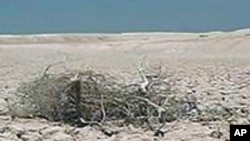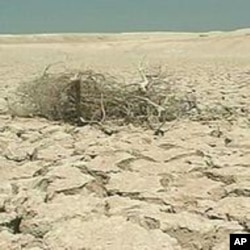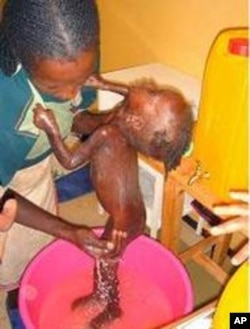In 1984, a devastating famine struck parts of East Africa. But by the time the world responded with aid, about one million people had died and crops and livestock were decimated. The tragedy revealed many flaws in communication and humanitarian aid response. Those lessons led to the creation of FEWSNET, the Famine Early Warning System Network.
There’s an old saying: Better late than never. But that doesn’t apply to famine. The 1984 famine may be best known for how it affected Ethiopia. Pictures of starving children were broadcast around the world. At the same time, there was also famine in western Sudan.
Gary Eilerts is FEWSNET program manager for USAID, the U.S. Agency for International Development.
At one point, he says, intervention appeared to be necessary. “And the administrator of (US)AID asked where [he should] send the food that was required to respond to that problem. And the response was simply to western Sudan. Now, anybody who knows how big western Sudan is knows that that’s like saying send the food to western United States,” he says.
Eilerts says that was typical of what was considered early warning at the time.
“It was filtering up from the ground. It would go through several levels. It would hit the ministries. It would go out into the news, then people would know that there was some starving going on someplace out in western Sudan. But really there wasn’t enough information to say where exactly to send the helicopter, where to drive the truck to, who exactly needed the food,” he says.
A very long time
“It probably took several months for that information to get up to the point where people were able to judge it credible and that it required an urgent response. So it was a long-term process just getting the information out,” he says.
USAID decided it needed its own system to get quick and accurate information on a developing crisis.
“In those days the problems were mostly found in the Sahel of Africa and Sudan and Ethiopia. So it was those places that we first set up the FEWSNET operation,” Eilerts says.
It was important to get first-hand information.
So, he says, when FEWSNET was created, “it was set up with the idea of being able to have a local presence and being able to go out into the country and to try to find those problems and define them as well as possible,” he says.
Many of the agencies that are now part of FEWSNET are based in the United States. These include the National Oceanic and Atmospheric Administration, NOAA, the space agency, NASA, the U.S. Geological Survey and the U.S. Department of Agriculture.
Early warning
Eilerts says, “It used to be until just a couple of years ago, everybody felt that they were getting an early warning if we gave a contemporaneous warning to something that was happening. We really weren’t talking about the future. We were desperately trying to describe the present, using information that we had from several weeks ago.”
Since then, communication has greatly improved.
“It’s only been in the last couple of years, with an improvement in communication and improvement in some of the satellite information we receive, FEWSNET is in the process of reorienting its whole message to be looking six months down the road into the future,” he says.
Eilerts says a six-month head start is vital because it may take that long to get food aid to where it’s needed.
“Six months down the road, we want to be able to say this is what’s going to happen,” he says.
He says FEWSNET has saved money, time, lives and livelihoods. It’s difficult to say just how many lives have been saved.
“What we’re aiming at is way before the lives that are lost. We want to save people’s livelihoods. Because once they get to destitution they really don’t have much future. So, we’re really aiming to address the needs before they are threatened by a lack of food,” he says.
Is it really famine?
The word “famine” has often been used freely for various situations in which people’s lives may be at risk due to food insecurity. But not all uses of the word are appropriate.
“Many people do use it in the wrong sense. There are various ways you can define it. The biblical way that it used to be defined is the way that many people do refer to it and that is often not very helpful in describing what’s going on. It’s often not very accurate about what the dynamics are at the local level,” he says.
What’s more, says Eilerts, “It’s very rare that people actually starve to death. It’s much more common that they’re going to die from complications that arise from being [poorly] nourished.”
There are other reasons as well.
“Many of the people who are commonly [thought] to be living a famine are actually dying because of malaria or poor water that causes illnesses. So, the word “famine” is a problematic one in that sense. It doesn’t describe very well what’s going on and it often does not describe the type of response that’s required,” he says.
Eilerts says as a result, distinctions are made between problems caused by a lack of food and problems resulting from persistent poverty. If poverty is at the root of the problem, he says measures need to be taken to improve drinking water and sanitation, combat malaria, create jobs and improve education.
In recent years, East Africa has been hit hard by a severe drought. Has that been classified as a potential famine yet?
“No, but that is definitely the epicenter of hunger in the world today. There are so many things going on there. It’s not just one season that they’ve lost. They’ve actually had several years of drought. In fact, we’ve never seen such consecutive drought years as we have seen in the last four years. That all is leading to a disintegration of people’s livelihoods in that area,” he says.
While rains are now falling in many areas as a result of El Nino, they are not expected to erase the all damage done by years of drought. In fact, some fear the rains will only bring floods and disease.
FEWSNET works closely with many U.N. and other humanitarian agencies in trying to respond to those in need in a timely manner. But this year, many agencies say the cost of feeding those in need in East Africa has soared, due not only to drought, but to conflict as well.







